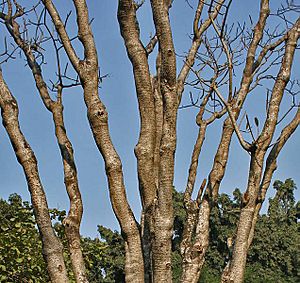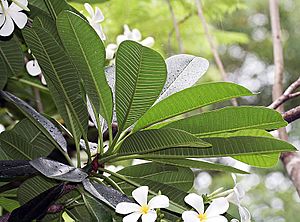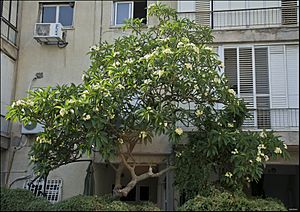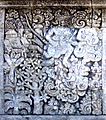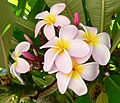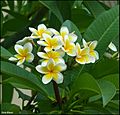Frangipani facts for kids
Quick facts for kids Plumeria |
|
|---|---|
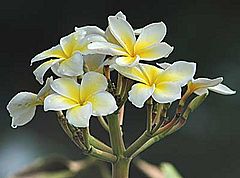 |
|
| Plumeria alba (White Frangipani) | |
| Scientific classification | |
| Kingdom: | |
| Division: | |
| Class: | |
| Order: | |
| Family: | |
| Genus: |
Plumeria
|
Plumeria (also called Frangipani) is a small group of 7-8 plant species. These plants grow in warm, tropical, and subtropical parts of the Americas. Most Plumeria plants are deciduous shrubs or trees, meaning they lose their leaves each year. One well-known type, P. rubra (Common Frangipani), grows in Mexico, Central America, and Venezuela. Its flowers can be yellow or pink. From Mexico and Central America, Plumeria has spread to many tropical places around the world, especially Hawaii. It grows so much there that many people think it is a native plant.
Amazing Plumeria Flowers
Plumeria flowers are most fragrant at night. They do this to attract sphinx moths for pollination. The flowers don't actually have any nectar, so they trick the moths! The moths accidentally pollinate the flowers as they fly from one to another, searching for nectar that isn't there.
How Plumeria Plants Grow
You can easily grow new Plumeria plants from cuttings. In spring, you can cut the tips of leafless stems. Let these cuttings dry at the bottom before you plant them in soil that drains well. It's important that the soil isn't too wet, as the cuttings can rot easily.
There are over 300 different types of Plumeria plants that have been named.
Plumeria in Culture and History
For more than 2000 years, Plumeria has been very important in Mesoamerica. Ancient civilizations like the Maya and Aztec used them in special ways. Even today, they hold deep meaning.
Plumeria Around Asia
Plumeria plants are now common in southern and southeastern Asia. In some local stories, people believe these trees offer shelter to spirits. The scent of Plumeria has also been linked to certain mythical creatures in Malay folklore. Because of this, frangipani trees are often planted in cemeteries. They are also connected to temples in Hindu, Jain, and Buddhist cultures.
Plumeria in Pacific Islands
In many Pacific islands, like Tahiti, Fiji, Samoa, Hawaii, and Tonga, Plumeria flowers are used to make beautiful leis. A lei is a garland or wreath. In modern Polynesian culture, women sometimes wear a Plumeria flower to show if they are in a relationship. If worn over the right ear, it means they are looking for a relationship. If worn over the left, it means they are already taken.
National Flowers and Local Names
Plumeria rubra is the national flower of Nicaragua. There, it is known as "sacuanjoche." Plumeria alba is the national flower of Laos, where it is called champa.
Cultural Meanings in Different Countries
In some Bengali traditions, most white flowers, especially Plumeria (called chômpa or chãpa), are sometimes linked to funerals.
In the Philippines and Indonesia, Plumeria is known as Kalachuchi or Kalatsutsi. It is sometimes connected to spirits and graveyards. Plumeria trees are often planted in cemeteries in both countries. However, they are also popular ornamental plants in homes, parks, and other public places in the Philippines. Balinese Hindus use the flowers in their temple offerings.
In Malaysia, the scent of Plumeria is sometimes linked to a mythical creature called the pontianak.
Plumeria in Incense
Indian incenses that smell like Plumeria rubra often have "champa" in their names. For example, Nag Champa is an incense that mixes the smell of Plumeria with sandalwood. While Plumeria is part of Indian champa incense, the amount used can change depending on the recipe.
Plumeria in Indian Weddings
In the Kannada language spoken in the Old Mysore region of Karnataka, India, the flower is called Devaga Nagale. In the Western Ghats of Karnataka, people use cream-colored Plumeria in weddings. The groom and bride exchange Plumeria garlands. It is also called devaganagalu or devakanagalu, which means "God's Plumeria." Red Plumeria flowers are not used in weddings. Plumeria plants are found in most temples in these areas.
Plumeria in Sri Lanka and Africa
In Sri Lankan traditions, Plumeria is connected to worship. A painting from the fifth-century rock fortress Sigiriya shows a heavenly figure holding a five-petaled flower that looks just like Plumeria.
In Eastern Africa, frangipani is sometimes mentioned in Swahili love poems.
Medicinal Uses
Some types of Plumeria have been studied to see if they have any medicinal benefits.
Images for kids
-
Plumeria relief in Penataran temple, Blitar, East Java
-
Red frangipani found in Malaysia.
-
White Plumeria, found at Andhra Pradesh
See also
 In Spanish: Plumeria para niños
In Spanish: Plumeria para niños


